A Quadruple Gene-Deleted Live BoHV-1 Subunit RVFV Vaccine Vector Reactivates from Latency and Replicates in the TG Neurons of Calves but Is Not Transported to and Shed from Nasal Mucosa
Abstract
:1. Introduction
2. Materials and Methods
2.1. Ethical Statement
2.2. Cells and Medium
2.3. Viruses
2.4. Antibodies
2.5. Animal Experiment
2.6. Clinical Parameter and Sample Collection
2.7. Necropsy and Sample Collection
2.8. Serum Virus Neutralization Assay
2.9. DNA/RNA Isolation, cDNA Synthesis, and BoHV-1-Specific Quantitative PCR (q-PCR)
2.10. Indirect Immunofluorescence Assay
2.11. Statistical Analysis
3. Results
3.1. Clinical Signs and Nasal Virus Shedding of BoHV-1qmv Sub-RVFV- and BoHV-1qmv Vector-Infected/Vaccinated Calves Compared with the BoHV-1 wild-type (wt)-Infected Calves
3.2. Nasal Virus Shedding following Intranasal (IN) Infection of BoHV-1 wt, BoHV-1qmv Vector, and BoHV-1qmv Sub-RVFV
3.3. Following Dex-Induced Reactivation, Only the BoHV-1 wt-Infected Calves Shed the Virus in the Nose
3.4. Like BoHV-1 wt, BoHV-1qmv, and BoHV-1qmv Sub-RVFV Established Latency, Was Reactivated from Latency, Expressed Immediate Early Protein 0 (ICP0), and DNA Replication-Dependent True Late Envelope Protein gC in the TG Neurons but Unlike the BoHV-1 wt Was Not Transported from the TG to and Shed in the Nose
3.5. Infiltration of Inflammatory Cells in the TGs of the BoHV-1 wt-Infected Calves during Latency and upon Reactivation but Not in TGs of BoHV-1qmv- and BoHV-1qmv Sub-RVFV-Infected Calves
3.6. Dexamethasone-Induced Latency Reactivation Resulted in Memory-Neutralizing Antibody Response Only for BoHV-1 wt-Infected Calves but Not for the BoHV-1qmv- and BoHV-1qmv Sub-RVFV-Infected Calves, Validating Another Way of BoHV-1 wt Reactivation in and Transport from the TG to Nasal Mucosa, Followed by Replication and Shedding in the Nasal Mucosa
4. Discussion
5. Conclusions
Supplementary Materials
Author Contributions
Funding
Institutional Review Board Statement
Informed Consent Statement
Data Availability Statement
Acknowledgments
Conflicts of Interest
References
- Ellis, J.A. Update on viral pathogenesis in BRD. Anim. Health Res. Rev. 2009, 10, 149–153. [Google Scholar] [CrossRef] [PubMed]
- Griffin, D.; Chengappa, M.M.; Kuszak, J.; McVey, D.S. Bacterial pathogens of the bovine respiratory disease complex. Vet. Clin. N. Am. Food Anim. Pract. 2010, 26, 381–394. [Google Scholar] [CrossRef]
- Zhou, Y.; Shao, Z.; Dai, G.; Li, X.; Xiang, Y.; Jiang, S.; Zhang, Z.; Ren, Y.; Zhu, Z.; Fan, C.; et al. Pathogenic infection characteristics and risk factors for bovine respiratory disease complex based on the detection of lung pathogens in dead cattle in Northeast China. J. Dairy. Sci. 2023, 106, 589–606. [Google Scholar] [CrossRef] [PubMed]
- Graham, D.A. Bovine herpes virus-1 (BoHV-1) in cattle-a review with emphasis on reproductive impacts and the emergence of infection in Ireland and the United Kingdom. Ir. Vet. J. 2013, 66, 15. [Google Scholar] [CrossRef] [PubMed]
- Winkler, M.T.; Doster, A.; Sur, J.H.; Jones, C. Analysis of bovine trigeminal ganglia following infection with bovine herpesvirus 1. Vet. Microbiol. 2002, 86, 139–155. [Google Scholar] [CrossRef] [PubMed]
- Kutish, G.; Mainprize, T.; Rock, D. Characterization of the latency-related transcriptionally active region of the bovine herpesvirus 1 genome. J. Virol. 1990, 64, 5730–5737. [Google Scholar] [CrossRef]
- Jones, C.; Geiser, V.; Henderson, G.; Jiang, Y.; Meyer, F.; Perez, S.; Zhang, Y. Functional analysis of bovine herpesvirus 1 (BHV-1) genes expressed during latency. Vet. Microbiol. 2006, 113, 199–210. [Google Scholar] [CrossRef]
- Jones, C.; Chowdhury, S. A review of the biology of bovine herpesvirus type 1 (BHV-1), its role as a cofactor in the bovine respiratory disease complex and development of improved vaccines. Anim. Health Res. Rev. 2007, 8, 187–205. [Google Scholar] [CrossRef]
- Ostler, J.B.; Jones, C. The Bovine Herpesvirus 1 Latency-Reactivation Cycle, a Chronic Problem in the Cattle Industry. Viruses 2023, 15, 552. [Google Scholar] [CrossRef]
- Ata, A.; Kale, M.; Yavru, S.; Bulut, O.; Buyukyoruk, U. The effect of sub-clinical BoHV-1 infection on fertility of cows and heifers. Acta Vet. 2006, 56, 267–273. [Google Scholar]
- O’Toole, D.; Van Campen, H. Abortifacient vaccines and bovine herpesvirus-1. J. Am. Vet. Med. Assoc. 2010, 237, 259–260. [Google Scholar] [PubMed]
- Fulton, R.W.; d’Offay, J.M.; Eberle, R. Bovine herpesvirus-1: Comparison and differentiation of vaccine and field strains based on genomic sequence variation. Vaccine 2013, 31, 1471–1479. [Google Scholar] [CrossRef] [PubMed]
- van Drunen Littel-van den Hurk, S.; Myers, D.; Doig, P.A.; Karvonen, B.; Habermehl, M.; Babiuk, L.A.; Jelinski, M.; Van Donkersgoed, J.; Schlesinger, K.; Rinehart, C. Identification of a mutant bovine herpesvirus-1 (BHV-1) in post-arrival outbreaks of IBR in feedlot calves and protection with conventional vaccination. Can. J. Vet. Res. 2001, 65, 81–88. [Google Scholar]
- van Drunen Littel-van den Hurk, S. Rationale and perspectives on the success of vaccination against bovine herpesvirus-1. Vet. Microbiol. 2006, 113, 275–282. [Google Scholar] [CrossRef]
- Dispas, M.; Schynts, F.; Lemaire, M.; Letellier, C.; Vanopdenbosch, E.; Thiry, E.; Kerkhofs, P. Isolation of a glycoprotein E-deleted bovine herpesvirus type 1 strain in the field. Vet. Rec. 2003, 153, 209–212. [Google Scholar] [CrossRef] [PubMed]
- Chowdhury, S.I.; Mahmood, S.; Simon, J.; Al-Mubarak, A.; Zhou, Y. The Us9 gene of bovine herpesvirus 1 (BHV-1) effectively complements a Us9-null strain of BHV-5 for anterograde transport, neurovirulence, and neuroinvasiveness in a rabbit model. J. Virol. 2006, 80, 4396–4405. [Google Scholar] [CrossRef]
- Yezid, H.; Lay, C.T.; Pannhorst, K.; Chowdhury, S.I. Two Separate Tyrosine-Based YXXL/Φ Motifs within the Glycoprotein E Cytoplasmic Tail of Bovine Herpesvirus 1 Contribute in Virus Anterograde Neuronal Transport. Viruses 2020, 12, 1025. [Google Scholar] [CrossRef]
- Butchi, N.B.; Jones, C.; Perez, S.; Doster, A.; Chowdhury, S.I. Envelope protein Us9 is required for the anterograde transport of bovine herpesvirus type 1 from trigeminal ganglia to nose and eye upon reactivation. J. Neurovirol. 2007, 13, 384–388. [Google Scholar] [CrossRef]
- Brum, M.C.; Coats, C.; Sangena, R.B.; Doster, A.; Jones, C.; Chowdhury, S.I. Bovine herpesvirus type 1 (BoHV-1) anterograde neuronal transport from trigeminal ganglia to nose and eye requires glycoprotein E. J. Neurovirol. 2009, 15, 196–201. [Google Scholar] [CrossRef]
- Liu, Z.F.; Brum, M.C.; Doster, A.; Jones, C.; Chowdhury, S.I. A bovine herpesvirus type 1 mutant virus specifying a carboxyl-terminal truncation of glycoprotein E is defective in anterograde neuronal transport in rabbits and calves. J. Virol. 2008, 82, 7432–7442. [Google Scholar] [CrossRef]
- Chowdhury, S.I.; Wei, H.; Weiss, M.; Pannhorst, K.; Paulsen, D.B. A triple gene mutant of BoHV-1 administered intranasally is significantly more efficacious than a BoHV-1 glycoprotein E-deleted virus against a virulent BoHV-1 challenge. Vaccine 2014, 32, 4909–4915. [Google Scholar] [CrossRef] [PubMed]
- Chowdhury, S.I.; Brum, M.C.; Coats, C.; Doster, A.; Wei, H.; Jones, C. The bovine herpesvirus type 1 envelope protein Us9 acidic domain is crucial for anterograde axonal transport. Vet. Microbiol. 2011, 152, 270–279. [Google Scholar] [CrossRef] [PubMed]
- Bryant, N.A.; Davis-Poynter, N.; Vanderplasschen, A.; Alcami, A. Glycoprotein G isoforms from some alphaherpesviruses function as broad-spectrum chemokine binding proteins. EMBO J. 2003, 22, 833–846. [Google Scholar] [CrossRef] [PubMed]
- Chowdhury, S.I.; Pannhorst, K.; Sangewar, N.; Pavulraj, S.; Wen, X.; Stout, R.W.; Mwangi, W.; Paulsen, D.B. BoHV-1-Vectored BVDV-2 Subunit Vaccine Induces BVDV Cross-Reactive Cellular Immune Responses and Protects against BVDV-2 Challenge. Vaccines 2021, 9, 46. [Google Scholar] [CrossRef]
- Pavulraj, S.; Stout, R.W.; Barras, E.D.; Paulsen, D.B.; Chowdhury, S.I. A Novel Quadruple Gene-Deleted BoHV-1-Vectored RVFV Subunit Vaccine Induces Humoral and Cell-Mediated Immune Response against Rift Valley Fever in Calves. Viruses 2023, 15, 2183. [Google Scholar] [CrossRef]
- Shapira, M.; Homa, F.L.; Glorioso, J.C.; Levine, M. Regulation of the herpes simplex virus type 1 late (gamma 2) glycoprotein C gene: Sequences between base pairs −34 to +29 control transient expression and responsiveness to transactivation by the products of the immediate early (alpha) 4 and 0 genes. Nucleic Acids Res. 1987, 15, 3097–3111. [Google Scholar] [CrossRef]
- Winkler, M.T.; Doster, A.; Jones, C. Persistence and reactivation of bovine herpesvirus 1 in the tonsils of latently infected calves. J. Virol. 2000, 74, 5337–5346. [Google Scholar] [CrossRef]
- Pavulraj, S.; Bera, B.C.; Joshi, A.; Anand, T.; Virmani, M.; Vaid, R.K.; Shanmugasundaram, K.; Gulati, B.R.; Rajukumar, K.; Singh, R.; et al. Pathology of Equine Influenza virus (H3N8) in Murine Model. PLoS ONE 2015, 10, e0143094. [Google Scholar] [CrossRef]
- Pavulraj, S.; Stout, R.W.; Paulsen, D.B.; Chowdhury, S.I. Live Triple Gene-Deleted Pseudorabies Virus-Vectored Subunit PCV2b and CSFV Vaccine Undergoes an Abortive Replication Cycle in the TG Neurons following Latency Reactivation. Viruses 2023, 15, 473. [Google Scholar] [CrossRef]
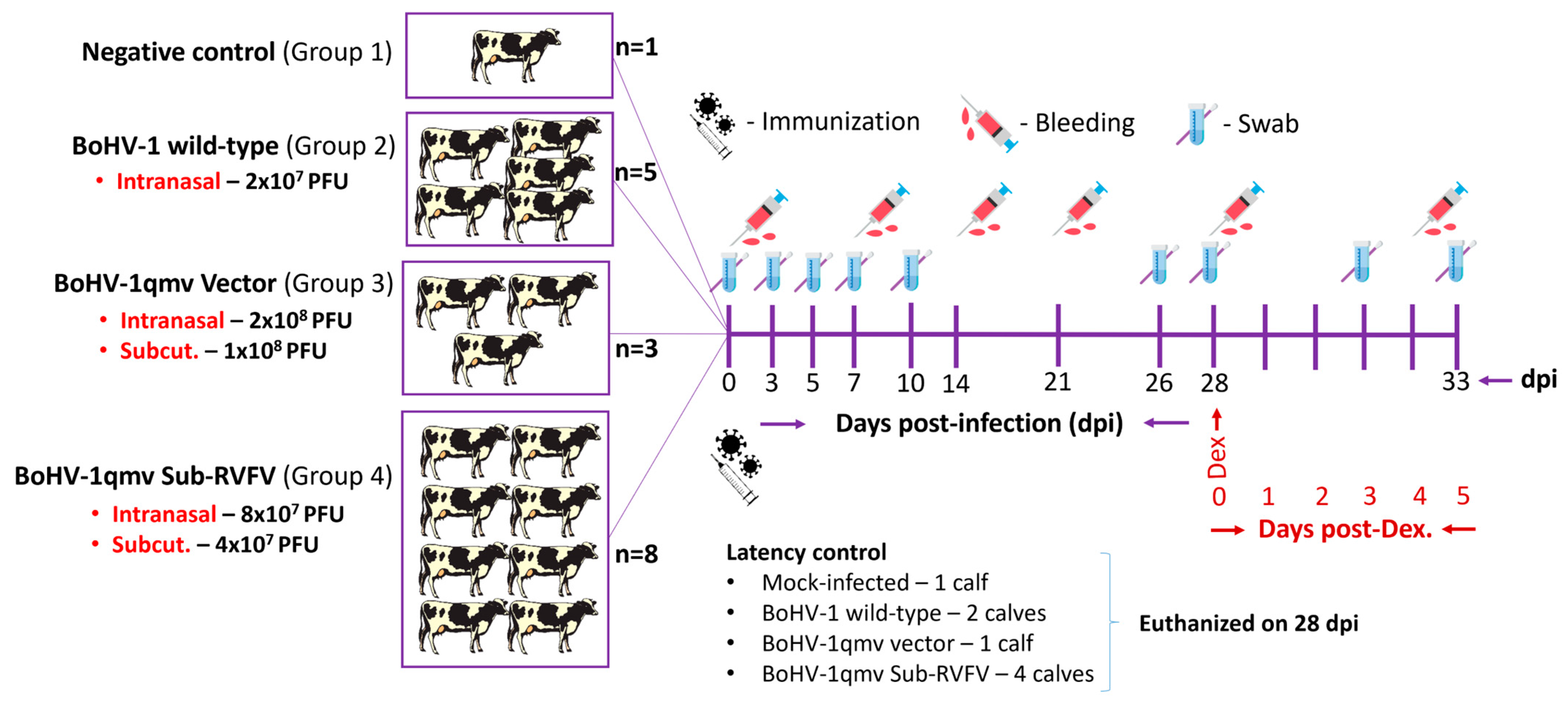

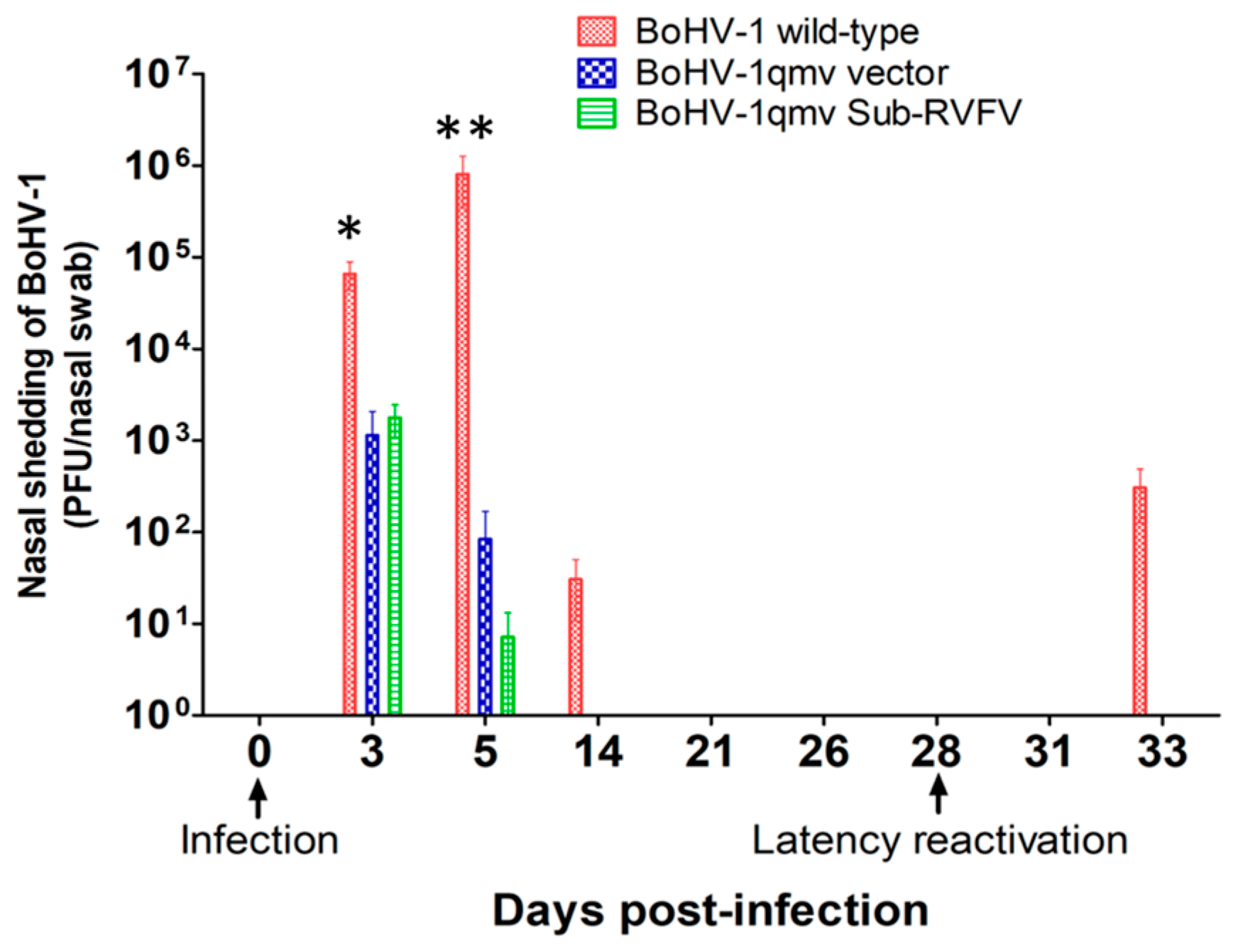



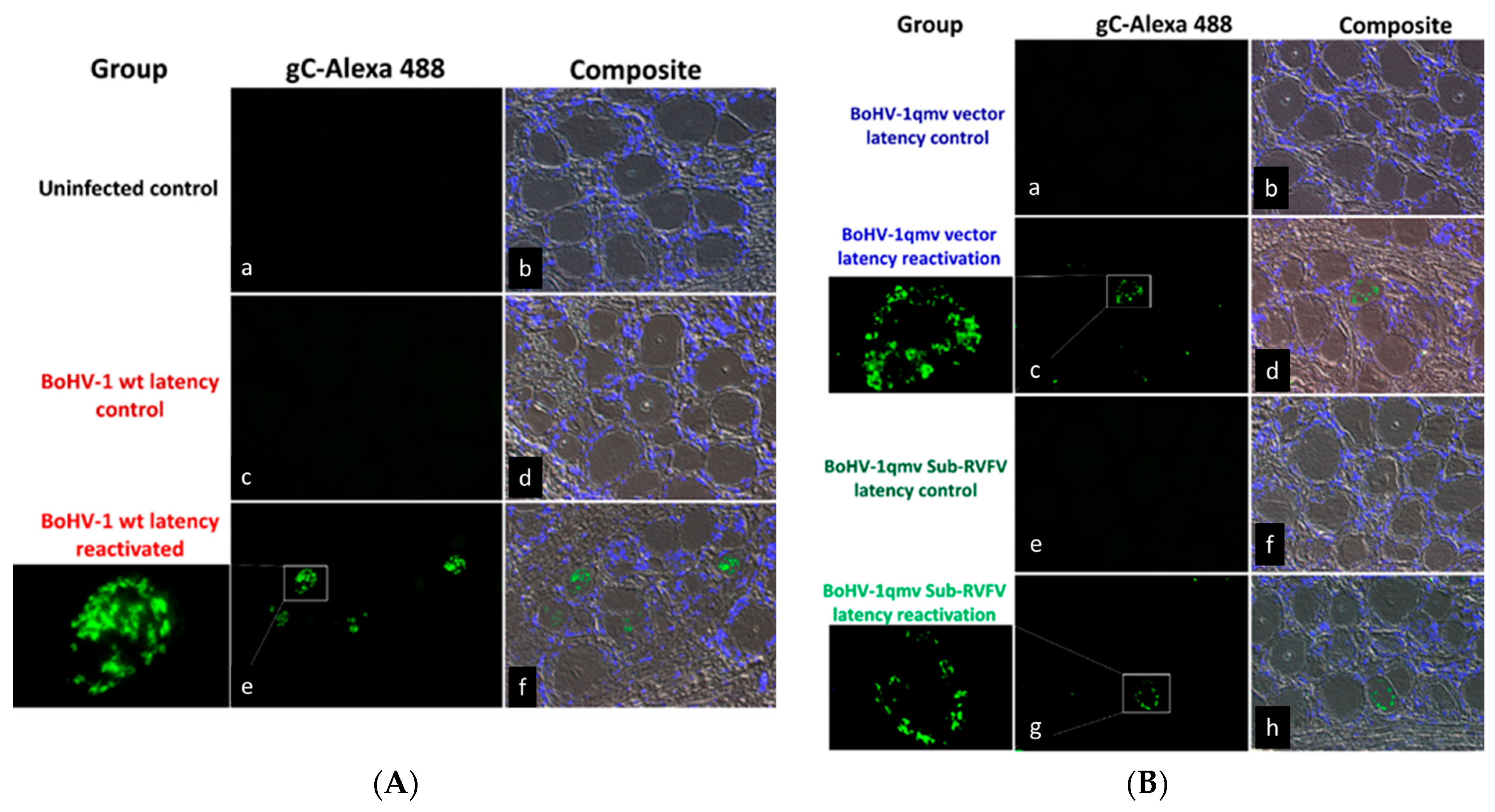
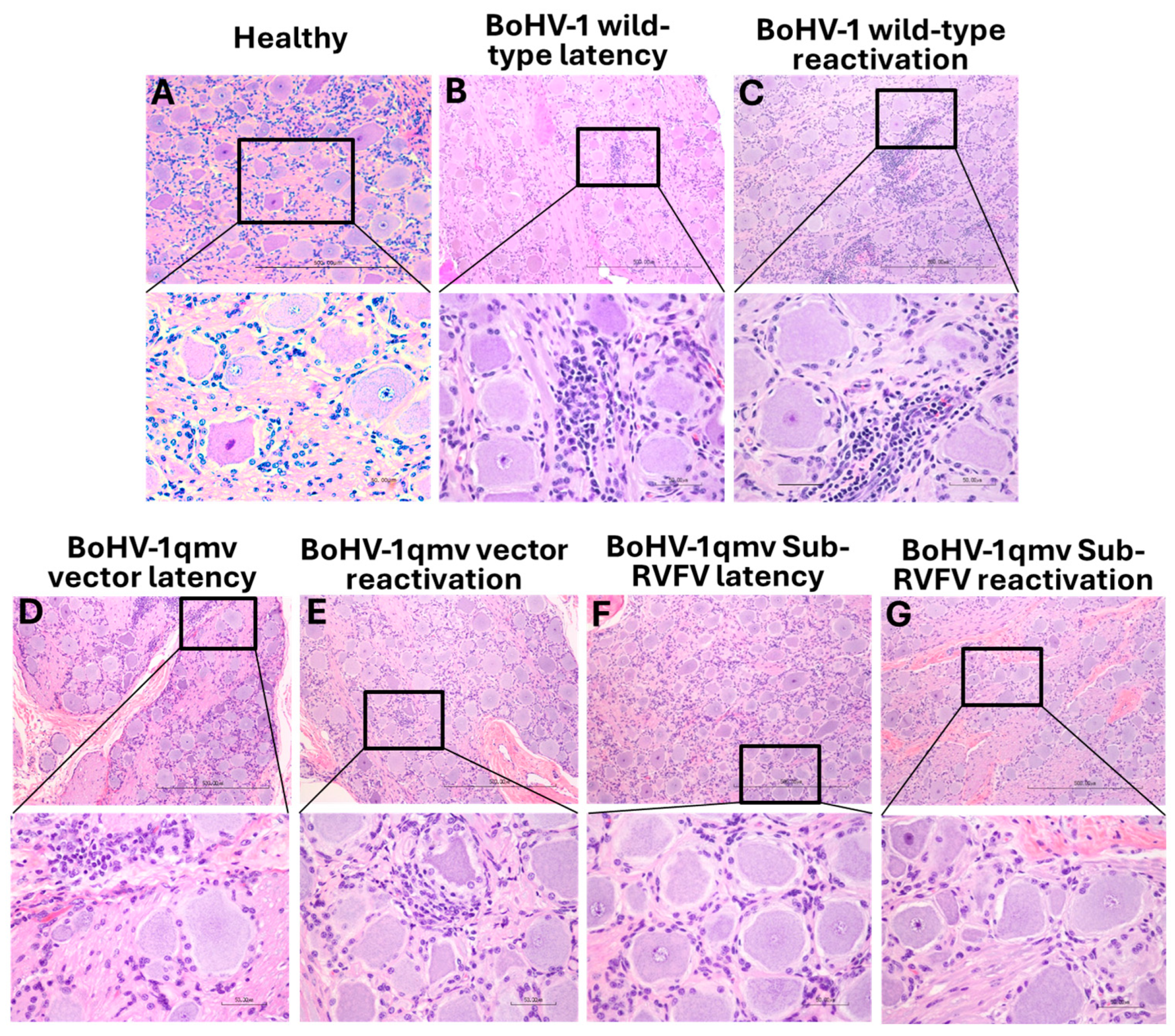
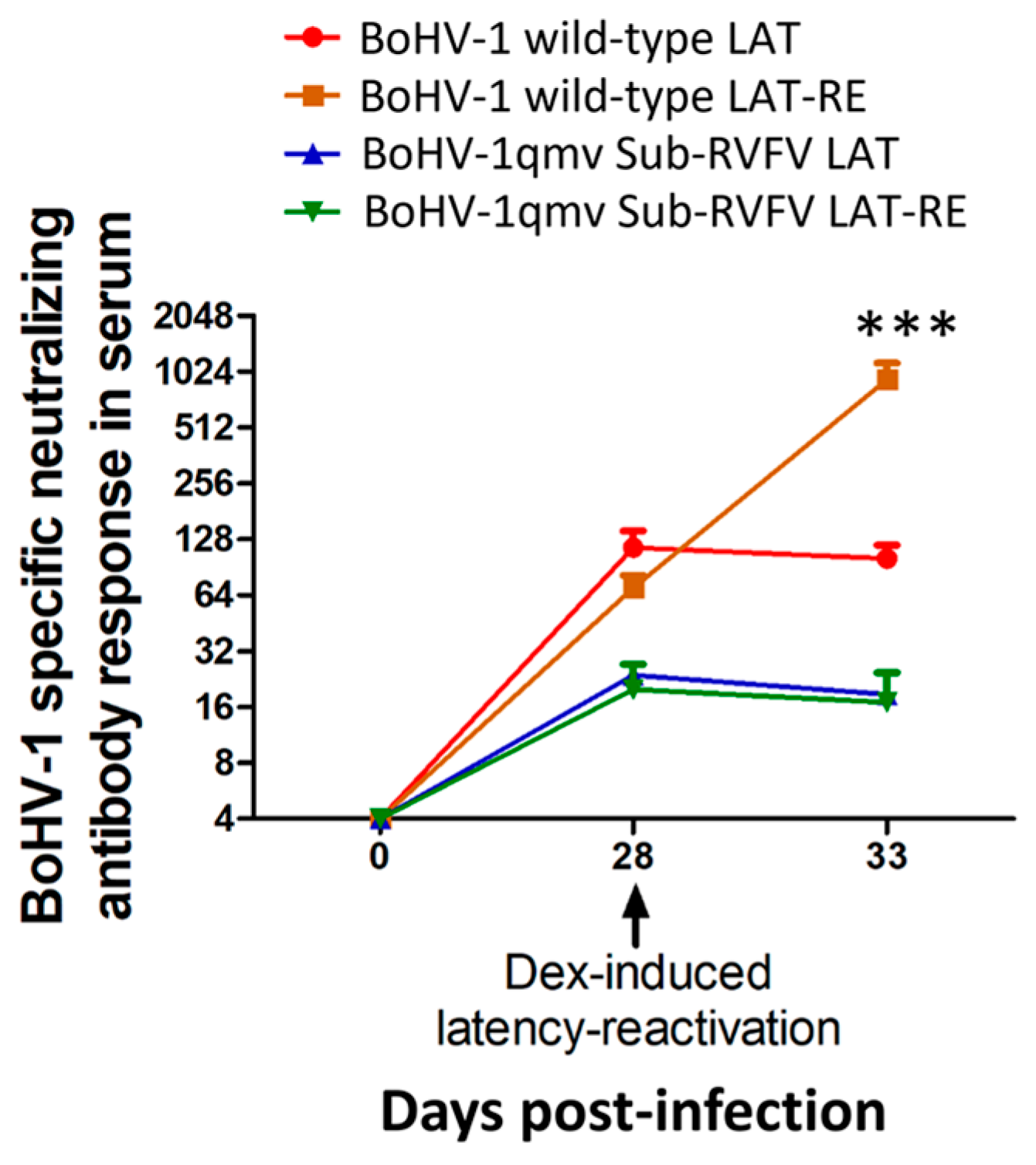
| Primer/Probe/ds-gBlock | Name | Sequence |
|---|---|---|
| BoHV-1 major capsid protein | Forward | 5′-TTTGGAGGCCCTAGAGAAGC-3′ |
| Reverse | 5′-AAACGTCAGGTCCATGTTGC-3′ | |
| Probe | 5′FAM-CGGGTGCCCTACCCGCTGGT-3′TAMRA | |
| ds-gBlock | 5′-CCGTTGGGGACCGGCTAGTGTTTTTGGAGGCCCTAGAGAAGCGC GTGTACCAGGCCACGCGGGTGCCCTACCCGCTGGTAGGCAACATGG ACCTGACGTTTGTCATGCCGCTGGGGCTGTACAAA-3′ | |
| BoHV-1 ICP0 | Forward | 5′-TGCTGACATACTGTCTTTCCGC-3′ |
| Reverse | 5′-CTTGGTCGGAGTCAGAAGAGTC-3′ | |
| Probe | 5′FAM-CGCCTCGACTCAACCTCCGCGTCCGTCT-3′IB®FQ | |
| ds-gBlock | 5′-TGTTTGTCGACCTCTAGTGCTGACATACTGTCTTTCCGCAGGCCCGGGC CGCGCCAGACGCCCCCCGCGTGCGCCTCGACTCAACCTCCGCGTCCGTCTCCGGCTCCGTTTCCGTGTCGTCAATGGCGGTCAGGTCGGAGGTGCTGAGCCCCGACGACGACTCTTCTGACTCCGACCAAGAGT-3′ | |
| BoHV-1 latency-related transcript | Forward | 5′-ACAGACAGACAAAAAGCCAG-3′ |
| Reverse | 5′-GTCATCCCCAAACCGAAAG-3′ | |
| Probe | 5′FAM - CATGCGCGACCTGGGCCATAA-3′IB®FQ | |
| ds-gBlock | 5′-TCAGAGTTTAATATTACAGACAGACAAAAAGCCAGATAATTACAAAGTATTT GTTTTTATTGATTGCGCATGCGCGACCTGGGCCATAAAAGCCCCGCGCATG CGCGAGCAGTTACTTTCGGTTTGGGGATGACAGCGGCGACTGCGGCT-3′ | |
| BoHV-1 glycoprotein C | Forward | 5′-ACCTTGCGCTGTGACTT-3′ |
| Reverse | 5′-GAGCTGGGCGACAACTAT-3′ | |
| Probe | 5′FAM-ATGTCGCGGCGCCAAGTGTA-3′IB®FQ | |
| ds-gBlock | 5′-GACGGTCACGACCTTGCGCTGTGACTTGGTGCCCATGTCGCGG CGCCAAGTGTACACGCCCTCGGTGGCGGCCGTCAGGGAGCGCACGGTCAGGGGCAAGTTGCGGGGGTCGGCGGGCGAAGGGAAAATATAGTTGTCGCCCAGCTCCGCGCTACGG-3′ | |
| RVFV Gn | Forward | 5′-AGACCAAGAGGGAGCTGAAG-3′ |
| Reverse | 5′-TCACCTGGATCTGCACGATG-3′ | |
| Probe | 5′FAM-CCAAGATCGGCGGCCACGGCTCCA-3′IB®FQ | |
| RVFV Gc | Forward | 5′-TGAAGGAGGACCAGACCAAG-3′ |
| Reverse | 5′-CACGTTGAAACATCCGCAG-3′ | |
| Probe | 5′FAM-CGGGACAACGAGACCAGCGCCGAGTTCA-3′IB®FQ | |
| Bovine glyceraldehyde 3-phosphate dehydrogenase (GAPDH) | Forward | 5′-CATGACCACTTTGGCATCGT-3′ |
| Reverse | 5′-CCATCCACAGTCTTCTGGGT-3′ | |
| Probe | 5′FAM-ACCACTGTCCACGCCATCACTGCC-3′TAMRA | |
| ds-gBlock | 5′-GGCCCCCCTGGCCAAGGTCATCCATGACCACTTTGGCATCG TGGAGGGACTTATGACCACTGTCCACGCCATCACTGCCACCCAGAA GACTGTGGATGGCCCCTCCGGGAAGCTGTGGCGT-3′ |
Disclaimer/Publisher’s Note: The statements, opinions and data contained in all publications are solely those of the individual author(s) and contributor(s) and not of MDPI and/or the editor(s). MDPI and/or the editor(s) disclaim responsibility for any injury to people or property resulting from any ideas, methods, instructions or products referred to in the content. |
© 2024 by the authors. Licensee MDPI, Basel, Switzerland. This article is an open access article distributed under the terms and conditions of the Creative Commons Attribution (CC BY) license (https://creativecommons.org/licenses/by/4.0/).
Share and Cite
Pavulraj, S.; Stout, R.W.; Paulsen, D.B.; Chowdhury, S.I. A Quadruple Gene-Deleted Live BoHV-1 Subunit RVFV Vaccine Vector Reactivates from Latency and Replicates in the TG Neurons of Calves but Is Not Transported to and Shed from Nasal Mucosa. Viruses 2024, 16, 1497. https://doi.org/10.3390/v16091497
Pavulraj S, Stout RW, Paulsen DB, Chowdhury SI. A Quadruple Gene-Deleted Live BoHV-1 Subunit RVFV Vaccine Vector Reactivates from Latency and Replicates in the TG Neurons of Calves but Is Not Transported to and Shed from Nasal Mucosa. Viruses. 2024; 16(9):1497. https://doi.org/10.3390/v16091497
Chicago/Turabian StylePavulraj, Selvaraj, Rhett W. Stout, Daniel B. Paulsen, and Shafiqul I. Chowdhury. 2024. "A Quadruple Gene-Deleted Live BoHV-1 Subunit RVFV Vaccine Vector Reactivates from Latency and Replicates in the TG Neurons of Calves but Is Not Transported to and Shed from Nasal Mucosa" Viruses 16, no. 9: 1497. https://doi.org/10.3390/v16091497
APA StylePavulraj, S., Stout, R. W., Paulsen, D. B., & Chowdhury, S. I. (2024). A Quadruple Gene-Deleted Live BoHV-1 Subunit RVFV Vaccine Vector Reactivates from Latency and Replicates in the TG Neurons of Calves but Is Not Transported to and Shed from Nasal Mucosa. Viruses, 16(9), 1497. https://doi.org/10.3390/v16091497







